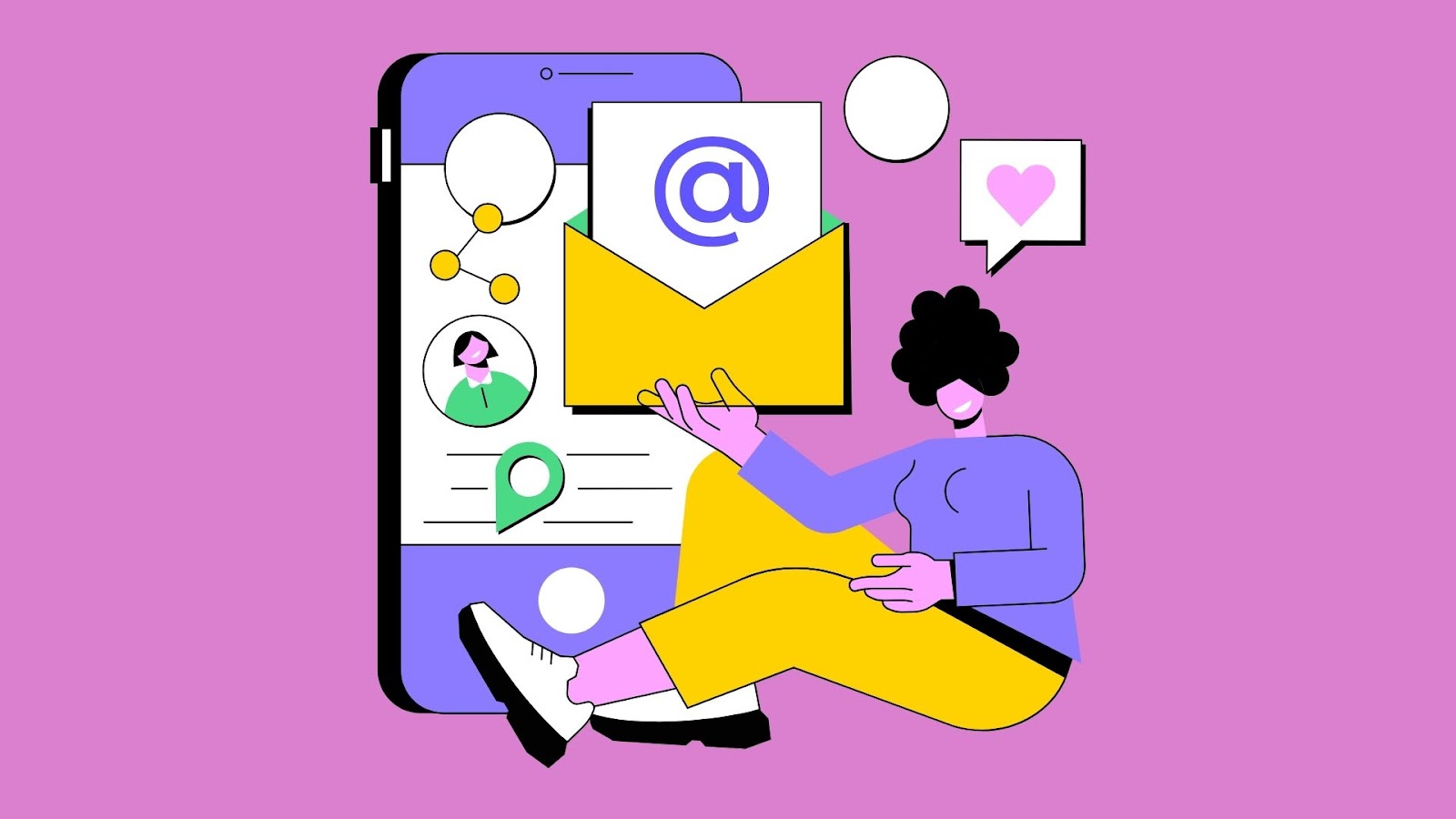Email marketing is tough.
Your emails need to be attractive yet valuable enough for your subscribers to engage. You need to entice conversions but can’t be too promotional at the same time. Your email design must be in sync with the latest design trends, but they have to be supported by your subscribers’ email clients.
But should that mean you give up on it?
Absolutely not. 99% of users check their emails daily. This means, emails are where your target audience is - you can’t afford to miss them. If email marketing overwhelms you, then these 15 email marketing tips will make executing successful campaigns a whole lot easier.
15 Email Marketing Tips for Successful Campaigns
Get your notepads and pens ready, as these 15 pro recommendations will take your email marketing game from 0 to 100.
1. Test subject lines before sending
Subject lines are like a candy shop - if the exterior doesn’t look fun, you won’t step inside it.
Subject lines matter because of two main reasons;
They capture your reader’s interest. 47% of recipients open emails solely based on the subject lines.
They filter out unsolicited emails. 69% of recipients report an email as spam after reading the subject line.

Since they’re so important, you must test subject lines before sending emails. Test them for spam trigger words, ensure total words are not more than 9, and don’t forget to personalize them. You can even use an online subject line tester that will show how strong or weak your subject line is.
2. Create a curiosity trap in subject lines
Let’s go back to creative writing 101. What did your professor tell you about writing an attractive introduction? Start with a question, make a strong statement, use relevant data, write a cliffhanger, or narrate a story.
Truth be told, your professor was right. When writing subject lines, you need to create a curiosity trap - capture your subscriber’s attention and maintain it long enough for him/her to open the email, read it, and click on any call to action buttons.
However, this interest-building in subject lines doesn’t follow a one-size-fits-all approach - it depends upon the email type. Different emails require different versions of curiosity-building subject lines. We explain this through the following subject line examples along with their respective email categories.
Welcome emails
We’re happy you’re here. Here’s a gift 💌
Follow up emails
Here’s how we can boost your sales by 48%
Thank you emails
Do you know how happy you make us?
Newsletters
Disclosing all our best-kept secrets 👀
Survey emails
My mom says she loves me. Do you?
Promotional emails
Can’t keep calm, we’re offering 50% off
3. Audit your email list
Every now and then, ensure you spring clean your email list.
Your goal with successful email marketing is not to reach millions but rather the right set of people. When you streamline your campaigns specifically for your target audience, you can witness an increase in deliverability, responses, conversions, and revenue.
Here’s how you can audit your email list:
Remove email addresses with typos, like randomperson@gmmail.com.
Clear out duplicate email addresses.
Get rid of any email IDs with the word ‘spam’ in them.
Take out inactive subscribers after receiving no responses from a re-engagement email.

4. Say no to generic design templates
The User Interface (UI) of a website is critical for its success. There are countless companies out there; should they all have the same UI? Absolutely not.
Similarly, you shouldn’t be sending different email messages in the same generic email template. Your email’s purpose will lose if you do so.
Opt for different email templates for different campaigns, events, and usages. At Unlayer, we have 1,000+ email templates for you to choose from. Grouped together in more than 70 categories, we have something in store for all your email marketing needs.
5. Feature double opt-ins
47% of people prefer to be reached by brands through emails. One major reason behind this liking is that emails are permission-based.
If you’re a normal person who despises buying email lists and builds their own, you must be familiar with opt-in forms. It’s a two-way request in which you ask for a prospect’s email address and give something valuable in return, aka a lead magnet. A double opt-in ensures a prospect really wants to hear from you.
Double opt-ins might seem annoying, but they make sure that there are no fake signups and the email addresses are valid. This also stops you from having to clean your email list multiple times.
How do double opt-ins work?
A prospect provides his/her email in an opt-in form
You send a confirmation email asking if they willingly signed up
The prospect becomes a subscriber once s/he clicks on the confirmation link
The following plain text email from Really Good Emails gets the job done in a humorous way.

6. Give preheader the same importance as subject lines
Remember how we said subject lines are important? Preheaders are equally important.
Our biggest email marketing pet peeve is ignoring preheaders. The latter is a snippet of text that appears after a subject line.
When subject lines fail to attract your subscribers, preheaders convince them to open an email. Since subject lines shouldn’t be more than 9 words, preheaders provide you with extra space to convey your message.
Include preheaders at all costs, but first, follow the below best practices:
Keep preheaders less than or equal to 80 characters.
Personalize the preheader if the subject line isn’t.
The preheader shouldn’t be a rephrased version of the subject line but should be related to it.
Add emojis to stand out in the inbox clutter.
7. Turn on frequency capping
Did you know that 55% of recipients ignore marketing emails because of inbox clutter?
When you send too many emails to your subscribers, you’re at risk of getting unsubscribed or, worse, flagged as spam.
How do you stop yourself from being too ambitious when sending emails? Turn on frequency capping. The latter is a feature offered by email marketing softwares that limits the number of emails you can send to your subscribers.

For instance, you executed a campaign to know about your subscribers’ email preferences. After analyzing all responses, the preference came to 3 emails per week. With frequency capping, the limit will be the 3 weekly emails, and the 4th weekly email won’t be sent. Hence, stopping you from bombarding your subscribers’ inbox.
8. Be updated with design trends
Would you rock a mullet today? Obviously not, that style was so 80s.
Your subscribers say the same when you send them emails that have an outdated email design.
For emails to attract and convert, your email design must be trendy. Staying up to date with trends gives a message that you care about the emails you send and hence, put in the extra effort.
However, don’t follow every trend that comes your way. Only implement those that are consistent with your brand personality and preferred by your audience. If you’re curious about the latest trends, this article covers them in detail.
9. Write in second-person viewpoint
$40.1 billion of sales have been generated from direct selling. Why is it so effective? When you sell directly to people, you reach a level of personalization that indirect marketing simply cannot. You’re able to convince prospects and upsell if the opportunity strikes.
You can incorporate direct selling in emails by writing email copy in the second-person viewpoint, i.e., you, your, and yourself. This gives the impression that you’re having a personal conversation with your audience. Hence, increasing the chances of them reading your email and converting.
10. Move past promotional emails
Gone are the days when brands would send emails only to promote an upcoming sale. Email marketing is much more diverse than the latter.
For emails to give you your desired results, you must consider it as a platform for nurturing leads. In fact, lead nurturing emails get 4-10 more replies than traditional ones.
Remember the buyer’s journey? It describes a customer’s path from awareness to consideration to decision. In simple terms, the journey in which a buyer becomes familiar with your brand, weighs down its pros and cons, and finally decides whether to purchase or not.
Your email marketing efforts must be in sync with the buyer’s journey. For the awareness stage, send welcome emails. For the consideration stage, send newsletters and brand story emails. For the decision stage, send promotional, thank you, and survey emails.

11. Focus on benefits, not features
We don’t mean to sound harsh, but it’s never about you - it’s always about your customers. Why should your audience care about how amazing your product is? Discuss how your product will make their life amazing and be prepared for high sales and profits.
Which of the below sentences have a greater impact?
Buy our soft matte, longwear foundation now.
Or
Our foundation ensures your face stays oil-free all day long without appearing cakey or patchy.
Obviously, the second one. We rest our case here.
12. Link to the right page
Be it embedded links or call to action buttons, the landing page you’re linking to must be aligned with your email message.
Most marketers get their email copy and design on point but fail to link to the right pages, which will ultimately lead to conversions.
There’s a simple trick for getting the links right. Before sending any email, think about the goal you want to achieve and the webpage that, once your prospect lands on, will achieve that goal. To understand this better, look at the below examples;
Product/collection launch email - Link to the collection’s page
Cold email - Link to the testimonial/case study page
Abandoned cart email - Link to the shopping cart page
Re-engagement email - Link to the settings page for preference management
13. Watch your tone
Like links, the tone of your message should be aligned with the type of email you’re sending.
If you’re sending a brand pitch email, use power words. Examples include guaranteed, improved, and expert. When sending a promotional email, use urgency-creating words, like immediately, hurry, now, and limited-time. With welcome emails, use optimistic and cheerful words, like happy, hope, and glad.
The overall tone and choice of words must reinforce the message of your email.
The following email from Artifact Uprising gets the tone absolutely right for its sale email.

14. Make content scannable
If you’re not making your email content scannable, you’re doing it wrong. Your copy’s layout matters because of two reasons:
Your subscribers are busy people.
The attention span of an average human is 8 seconds.

A long note in an email appears intimidating and scares the subscriber away from reading it. When your message is divided under headings, in bullets, or broken down into short paragraphs, you’ve crafted copy that is easier to read and digest.
15. Test and learn from your analysis
It’s the oldest trick in the book - monitor the performance of your email campaigns. However, we’ve noticed that marketers still prefer following industry best practices over following their own analysis.
Our recommendation? Make different hypotheses, A/B test to see if they work for your audience, and then implement the high-performing elements in your email marketing strategy.
Remember, testing is an ongoing process - it should never stop but rather be executed on the side.
The Final Rundown
Designing and launching successful email campaigns is no easy feat. But by following our tried and tested email marketing tips, you’ll become an email marketing expert in no time.
Got any tips to add? Comment below.





